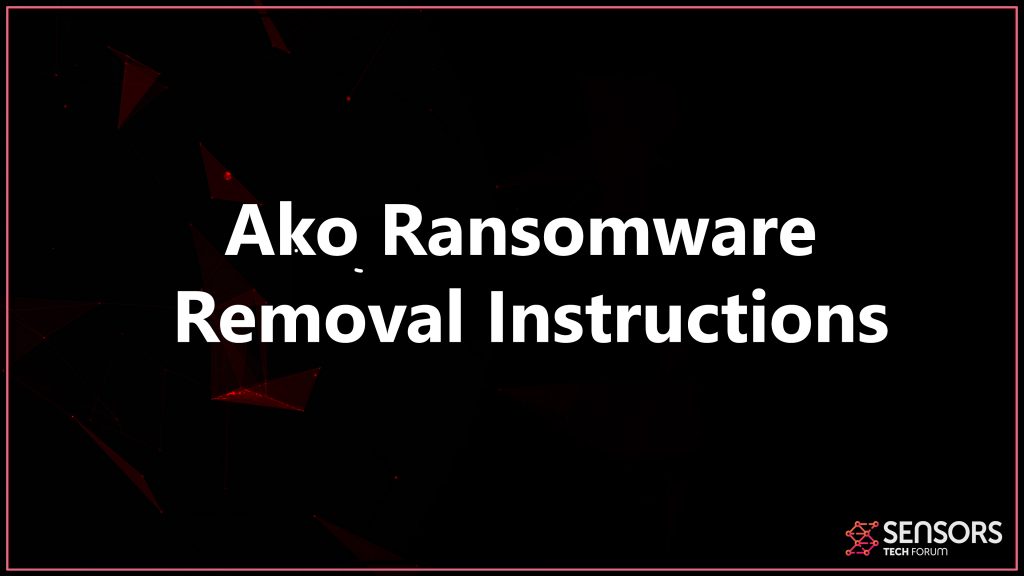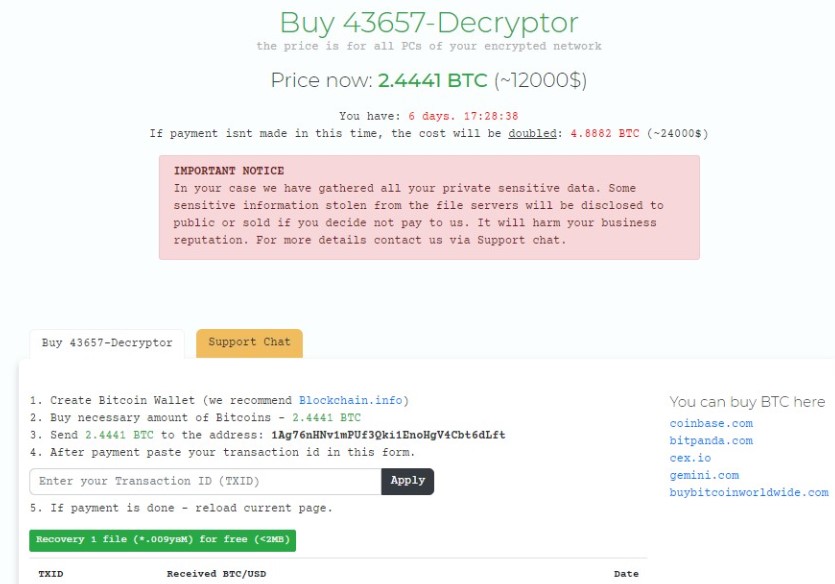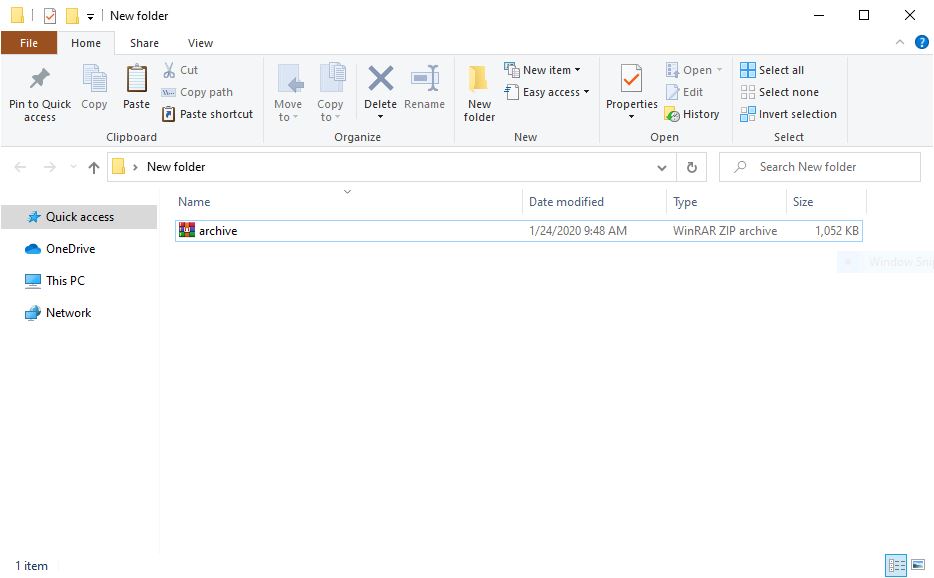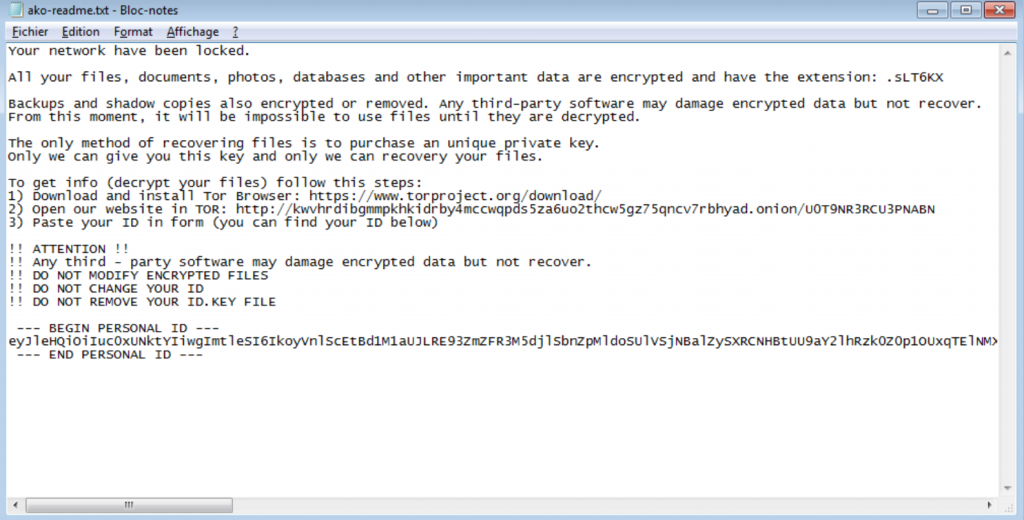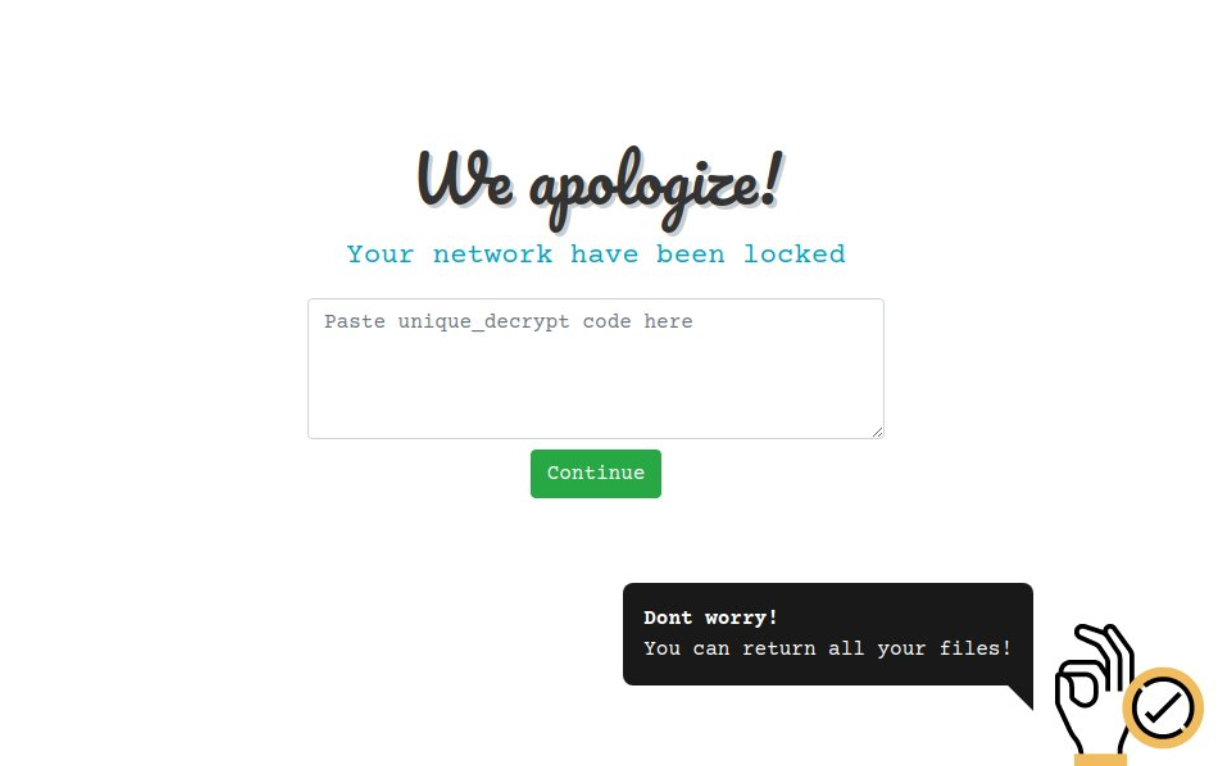Ako virus is a ransomware infection whose primary purpose is to encrypt files on your computer shortly after which add a random extension and its ransom note. The virus aims to extort you into paying BitCoin to get the files to work again. Read this article to learn how to remove Ako virus and try to restore your files.
Ako Virus Ransomware
The Ako ransomware is a part of dangeorus ransomware strain, which was discovered only recently. The virus aims to slip past your computer’s firewall and antivirus using sophisticated tactics of evasion and then encrypt them, using a powerful encryption algorithm. The main idea for this virus is to get you to read its ransom note (ako-readme.txt) and then get you to pay a hefty ransom fee to the cyber-criminals who are behind this infection.

Threat Summary
| Name | Ako ransomware |
| File Extension | Random A-Z 1-9. |
| Type | Ransomware, Cryptovirus |
| What Is It | A cryptovirus that can encode your files and hold them hostage in exchange for ransom payoff. |
| Symptoms | The files cannot be opened and the ransom note of the virus starts appearing. |
| Ransom Demanding Note | ako-readme.txt |
| Distribution Method | Spam Emails, Email Attachments, Executable Files, Hacked Websites |
| Removal | To effectively remove active Ako ransomware virus infections, we recommend that you use an advanced anti-malware tool. Download
Malware Removal Tool
|
User Experience | Join Our Forum to Discuss Ako ransomware. |
| Data Recovery Tool | Windows Data Recovery by Stellar Phoenix Notice! This product scans your drive sectors to recover lost files and it may not recover 100% of the encrypted files, but only few of them, depending on the situation and whether or not you have reformatted your drive. |
Ako Virus Ransomware March 2020 Updates
In March 2020 virus infections carrying the Ako ransomware continue to infect users worldwide. This shows that the criminals continue on and on with direct attacks and various infection campaigns with the aim of compromising as many computers as possible. Due to the recent rise in popularity of the ransomware we assume that it may be possible that several hacking groups are attempting to use the Ako ransomware samples in their intrusion attempts. Popular strategies will be used in order to manipulate the intended victims into infecting themselves with the threat.
A recently captured sample shows that the main virus is distributed as an executable file (.EXE). A detailed analysis reveals that it includes a lot of feature similarities and potentially even code snippets from some of the most advanced ransomware strains. This might mean that the latest version is producded by an experienced hacking group that is able to construct such an elaborate threat.
There are several very dangerous components which are integrated in the ransomware. One of the is the ability to remove Windows backups and also modify key operating system files. This makes file recovery very difficult and the victims will need to use a professional-grade data recovery solution in order to correct the problems.
The hackers have added an advanced security bypass function — it is able to resolve system APIs and evade static detection from security systems. This means that the ransomware can shut down program such as anti-virus programs, firewalls, debug environments and etc. The main engine can also hide the virus files and create multiple processes so that the virus code cannot be traced to a single file running on the system.
A specific feature of this new Ako virus ransomware of March 2020 shows that the engine will call a system data gathering module — we have confirmed that the ransomware can harvest remote session data. This can be used in the future if a Trojan module is integrated in the Ako ransomware.
When all modules have finished running the actual file encryption will start. The threat will run as intended and encrypt target user data with a strong cipher. The victims will have their valuable files renamed with a certain extension. They will be blackmailed into paying a decryption fee to access their files.
Ako Ransomware February 2020 Distribution
The Ako virus ransomware campaigns continue to grow as more and more victims continue to be affected by this threat. The latest attacks are set to attempt file encryption of not only the local computer, but also all network-connected hosts. There are several ways that such attacks can be organized:
- Personalized Campaign — The hackers can tweak the attack campaign so that it can affect certain types of users. This means that a careful pre-selection of potential candidates will be made and phishing strategies will be planned accordingly.
- Large-Scale Infections — The hackers can plan out large-scale attacks which can use several attack methods at once.
The hackers behind the current versions of the Ako ransomwaare are using mainly phishing email messages which will include a short title, description and an attached file. It is usually an archive ZIP file that will open a virus-infected file. There are several common types of data that are easy to include the ransomware — they can be macro-infected documents or setup bundles of popular applications. When the infection is done the common malware steps will continue.
In the end of January 2020 new information about the Ako ransomware became available. A sample analysis of the sent virus threats has revealed that the hacking group behind the ongoing infections is using a SPAM email messages distribution technique to infect the end targets. The email messages will mask as important business correspondence by looking like an important document or agreement that needs to be signed. The users will be manipulated into downloading and opening a password-protected ZIP archive which is described as having an important file in it. Everything will appear normal as the archive password will be quoted in the contents of the email. The file inside the ZIP archive will be called agreement.scr and when it is clicked on the Ako ransomware infection will start.
Ako Ransomware Description
Similar to .WannaScream virus , Ako ransomware can enter your computer via different forms of spreading techniques. One of them is If the virus files are uploaded on websites, whose main idea is to be downloaded onto your computer and ran. To get you to do this, those sites could mask the infection file of the Ako ransomware by make it seem as if it is a legitimate type of file, like a program, movie or any other torrent file. Often such files tend to end up being activators, patches, cracks and other types of files.
Another mehtod of infection via this nasty ransomware virus is if it enters your computer by posing as a document, like an invoice or some other type of file. The main difference here is that those files are sent to victims via e-mail and can pretend to be some important file that they must download and open, like a receipt for a purchase they made or a revoked plane ticket information, for example.
Either way, once the Ako ransomware has infiltrated your computer, it may begin to encrypt yor files leaving them with a radnom file extenison. The virus may encrypt your files using an advanced algorithm that makes them no longer able to be used. The outcome of this is that the files cannot be opened with any type of program and you end up stuck. After encryption, a unique decryption key is generated. This key could end up being sent to the cyber-criminals making them the only ones in power to decrypt your files. The main idea behind this is that you have to pay the crooks in order to use your files as it is written in the ako-readme.txt ransom note:
The ransom note is accompanied by a page that appears like the following:
The ransomware even goes as far as to restrict the victims access to most web pages besides the ransom extortionsts’ page.
The main purpose of this ransomware virus is to convince you into paying $3000 in the anonymous cryptocurrency BitCoin, which is very difficult to track by authorities. Be advised that it is not generally a good practice to pay the criminals and you should not do it, because there might be a decryptor for free later on.

Remove Ako Ransomware and Try to Get Back Files
If you want to get rid of Ako Ransomware from your computer, we recommend that you follow the instructions as they are written undeneath. They contain the necessary removal steps designed to help you take care of this nasty threat all at once. For maximum effectiveness, we strongly recommend that you use an advanced anti-malware software to take care of the removal for you. These programs have the necessary technology to remove such complicated threats thoroughly from your computer and make sure to protect your PC in the future as well.
If you are wondering how to get back your files, do not despair. You can still use some alternative methods to try and repair them, and you can stilll try to backup the files until researchers develop a decrypter or the hackers releaase the decryptor after their ransom campaign.
- Step 1
- Step 2
- Step 3
- Step 4
- Step 5
Step 1: Scan for Ako ransomware with SpyHunter Anti-Malware Tool



Ransomware Automatic Removal - Video Guide
Step 2: Uninstall Ako ransomware and related malware from Windows
Here is a method in few easy steps that should be able to uninstall most programs. No matter if you are using Windows 10, 8, 7, Vista or XP, those steps will get the job done. Dragging the program or its folder to the recycle bin can be a very bad decision. If you do that, bits and pieces of the program are left behind, and that can lead to unstable work of your PC, errors with the file type associations and other unpleasant activities. The proper way to get a program off your computer is to Uninstall it. To do that:


 Follow the instructions above and you will successfully delete most unwanted and malicious programs.
Follow the instructions above and you will successfully delete most unwanted and malicious programs.
Step 3: Clean any registries, created by Ako ransomware on your computer.
The usually targeted registries of Windows machines are the following:
- HKEY_LOCAL_MACHINE\Software\Microsoft\Windows\CurrentVersion\Run
- HKEY_CURRENT_USER\Software\Microsoft\Windows\CurrentVersion\Run
- HKEY_LOCAL_MACHINE\Software\Microsoft\Windows\CurrentVersion\RunOnce
- HKEY_CURRENT_USER\Software\Microsoft\Windows\CurrentVersion\RunOnce
You can access them by opening the Windows registry editor and deleting any values, created by Ako ransomware there. This can happen by following the steps underneath:


 Tip: To find a virus-created value, you can right-click on it and click "Modify" to see which file it is set to run. If this is the virus file location, remove the value.
Tip: To find a virus-created value, you can right-click on it and click "Modify" to see which file it is set to run. If this is the virus file location, remove the value.
Before starting "Step 4", please boot back into Normal mode, in case you are currently in Safe Mode.
This will enable you to install and use SpyHunter 5 successfully.
Step 4: Boot Your PC In Safe Mode to isolate and remove Ako ransomware





Step 5: Try to Restore Files Encrypted by Ako ransomware.
Method 1: Use STOP Decrypter by Emsisoft.
Not all variants of this ransomware can be decrypted for free, but we have added the decryptor used by researchers that is often updated with the variants which become eventually decrypted. You can try and decrypt your files using the instructions below, but if they do not work, then unfortunately your variant of the ransomware virus is not decryptable.
Follow the instructions below to use the Emsisoft decrypter and decrypt your files for free. You can download the Emsisoft decryption tool linked here and then follow the steps provided below:
1 Right-click on the decrypter and click on Run as Administrator as shown below:

2. Agree with the license terms:

3. Click on "Add Folder" and then add the folders where you want files decrypted as shown underneath:

4. Click on "Decrypt" and wait for your files to be decoded.

Note: Credit for the decryptor goes to Emsisoft researchers who have made the breakthrough with this virus.
Method 2: Use data recovery software
Ransomware infections and Ako ransomware aim to encrypt your files using an encryption algorithm which may be very difficult to decrypt. This is why we have suggested a data recovery method that may help you go around direct decryption and try to restore your files. Bear in mind that this method may not be 100% effective but may also help you a little or a lot in different situations.
Simply click on the link and on the website menus on the top, choose Data Recovery - Data Recovery Wizard for Windows or Mac (depending on your OS), and then download and run the tool.
Ako ransomware-FAQ
What is Ako ransomware Ransomware?
Ako ransomware is a ransomware infection - the malicious software that enters your computer silently and blocks either access to the computer itself or encrypt your files.
Many ransomware viruses use sophisticated encryption algorithms to make your files inaccessible. The goal of ransomware infections is to demand that you pay a ransom payment to get access to your files back.
What Does Ako ransomware Ransomware Do?
Ransomware in general is a malicious software that is designed to block access to your computer or files until a ransom is paid.
Ransomware viruses can also damage your system, corrupt data and delete files, resulting in the permanent loss of important files.
How Does Ako ransomware Infect?
Via several ways.Ako ransomware Ransomware infects computers by being sent via phishing emails, containing virus attachment. This attachment is usually masked as an important document, like an invoice, bank document or even a plane ticket and it looks very convincing to users.
Another way you may become a victim of Ako ransomware is if you download a fake installer, crack or patch from a low reputation website or if you click on a virus link. Many users report getting a ransomware infection by downloading torrents.
How to Open .Ako ransomware files?
You can't without a decryptor. At this point, the .Ako ransomware files are encrypted. You can only open them once they are decrypted using a specific decryption key for the particular algorithm.
What to Do If a Decryptor Does Not Work?
Do not panic, and backup the files. If a decryptor did not decrypt your .Ako ransomware files successfully, then do not despair, because this virus is still new.
Can I Restore ".Ako ransomware" Files?
Yes, sometimes files can be restored. We have suggested several file recovery methods that could work if you want to restore .Ako ransomware files.
These methods are in no way 100% guaranteed that you will be able to get your files back. But if you have a backup, your chances of success are much greater.
How To Get Rid of Ako ransomware Virus?
The safest way and the most efficient one for the removal of this ransomware infection is the use a professional anti-malware program.
It will scan for and locate Ako ransomware ransomware and then remove it without causing any additional harm to your important .Ako ransomware files.
Can I Report Ransomware to Authorities?
In case your computer got infected with a ransomware infection, you can report it to the local Police departments. It can help authorities worldwide track and determine the perpetrators behind the virus that has infected your computer.
Below, we have prepared a list with government websites, where you can file a report in case you are a victim of a cybercrime:
Cyber-security authorities, responsible for handling ransomware attack reports in different regions all over the world:
Germany - Offizielles Portal der deutschen Polizei
United States - IC3 Internet Crime Complaint Centre
United Kingdom - Action Fraud Police
France - Ministère de l'Intérieur
Italy - Polizia Di Stato
Spain - Policía Nacional
Netherlands - Politie
Poland - Policja
Portugal - Polícia Judiciária
Greece - Cyber Crime Unit (Hellenic Police)
India - Mumbai Police - CyberCrime Investigation Cell
Australia - Australian High Tech Crime Center
Reports may be responded to in different timeframes, depending on your local authorities.
Can You Stop Ransomware from Encrypting Your Files?
Yes, you can prevent ransomware. The best way to do this is to ensure your computer system is updated with the latest security patches, use a reputable anti-malware program and firewall, backup your important files frequently, and avoid clicking on malicious links or downloading unknown files.
Can Ako ransomware Ransomware Steal Your Data?
Yes, in most cases ransomware will steal your information. It is a form of malware that steals data from a user's computer, encrypts it, and then demands a ransom in order to decrypt it.
In many cases, the malware authors or attackers will threaten to delete the data or publish it online unless the ransom is paid.
Can Ransomware Infect WiFi?
Yes, ransomware can infect WiFi networks, as malicious actors can use it to gain control of the network, steal confidential data, and lock out users. If a ransomware attack is successful, it could lead to a loss of service and/or data, and in some cases, financial losses.
Should I Pay Ransomware?
No, you should not pay ransomware extortionists. Paying them only encourages criminals and does not guarantee that the files or data will be restored. The better approach is to have a secure backup of important data and be vigilant about security in the first place.
What Happens If I Don't Pay Ransom?
If you don't pay the ransom, the hackers may still have access to your computer, data, or files and may continue to threaten to expose or delete them, or even use them to commit cybercrimes. In some cases, they may even continue to demand additional ransom payments.
Can a Ransomware Attack Be Detected?
Yes, ransomware can be detected. Anti-malware software and other advanced security tools can detect ransomware and alert the user when it is present on a machine.
It is important to stay up-to-date on the latest security measures and to keep security software updated to ensure ransomware can be detected and prevented.
Do Ransomware Criminals Get Caught?
Yes, ransomware criminals do get caught. Law enforcement agencies, such as the FBI, Interpol and others have been successful in tracking down and prosecuting ransomware criminals in the US and other countries. As ransomware threats continue to increase, so does the enforcement activity.
About the Ako ransomware Research
The content we publish on SensorsTechForum.com, this Ako ransomware how-to removal guide included, is the outcome of extensive research, hard work and our team’s devotion to help you remove the specific malware and restore your encrypted files.
How did we conduct the research on this ransomware?
Our research is based on an independent investigation. We are in contact with independent security researchers, and as such, we receive daily updates on the latest malware and ransomware definitions.
Furthermore, the research behind the Ako ransomware ransomware threat is backed with VirusTotal and the NoMoreRansom project.
To better understand the ransomware threat, please refer to the following articles which provide knowledgeable details.
As a site that has been dedicated to providing free removal instructions for ransomware and malware since 2014, SensorsTechForum’s recommendation is to only pay attention to trustworthy sources.
How to recognize trustworthy sources:
- Always check "About Us" web page.
- Profile of the content creator.
- Make sure that real people are behind the site and not fake names and profiles.
- Verify Facebook, LinkedIn and Twitter personal profiles.


